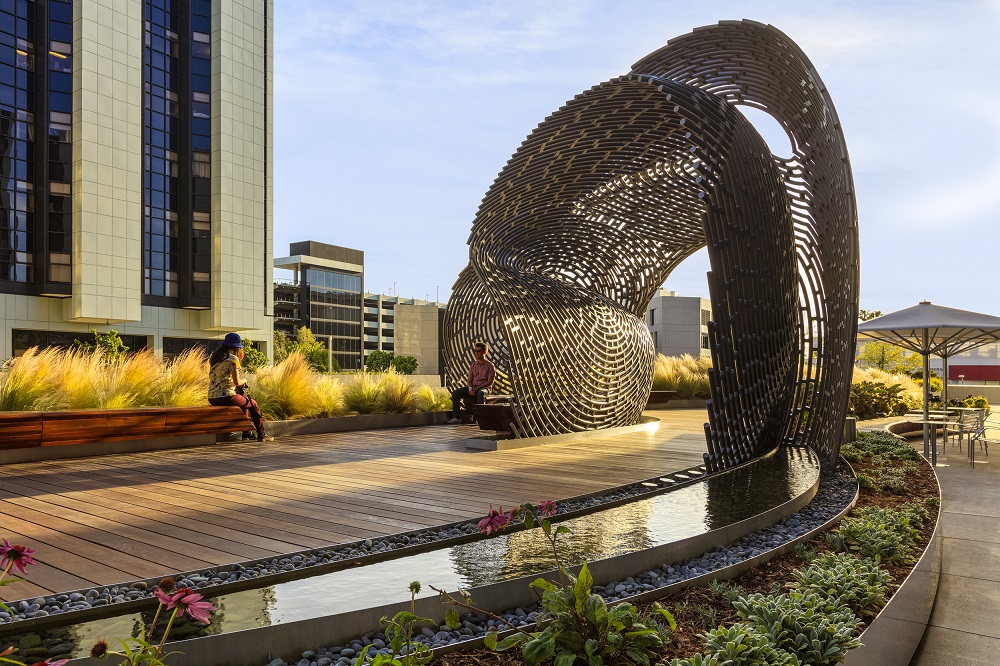Are water features wasteful? It’s a common misconception that indoor and outdoor water features are not sustainable amenities.
Many managers and owners of commercial facilities are surprised to learn that not only can attractive and captivating water features be operated with minimal waste or harm to the environment—they can actually help improve a building’s energy efficiency and reduce overall costs.

With World Sustainability Day on October 26, now is the perfect opportunity to consider the ways that water features can help buildings run more efficiently and debunk the misconceptions many have about their sustainability. In fact, there are a number of best practices that may help facility stakeholders enhance their sustainability efforts and decrease energy costs through strategic water feature operations.
Modern Design Techniques Work with Natural Resources
Modern-day water features are often designed with sustainability in mind so that they can be aesthetically pleasing, environmentally friendly, and helpful to the bottom line.
It all starts with the design process—through designing a fountain with reclaimed or recycled materials whenever possible and finding locally made resources for any new materials. This practice not only decreases the environmental impact of shipping building materials long-distance, but also supports local businesses and can help make the water feature a reflection of the local geography—especially if using natural stone or other resources found in the region.
In addition, a sustainable design can lower energy spending. For example, an outdoor water feature can act as a heat sink for a building’s HVAC system, creating a passive heat exchange that reduces energy use. Likewise, an indoor water feature can lower humidity in the area around it, which can also decrease energy costs for the building overall.
In terms of water usage, most water features today run on recirculated water, so they are not continuously drawing on new water resources to run. The only water that needs to be replenished in a water feature is to account for splash, leakage, or evaporation. All three can be mitigated with proper design, quality construction, and ongoing maintenance, and evaporative loss can be offset with a sustainable source for water refill. Condensate from the building’s air conditioning system can be repurposed as refill water, and some states allow rainwater capture systems or reclaimed grey water (from sinks or other non-sewer sources) to be used for makeup water. These alternatives are all less expensive and less environmentally taxing than refill water that comes directly from a potable water source.
Saving Money with Maintenance & Technology
The efficient and eco-friendly aspects of water features that start with sustainable design and materials can be continued—and improved—through strategic operations and upkeep. With regular monitoring and maintenance, water loss can be minimized, thereby reducing overhead costs.
Like many other amenities and building systems, much of the routine maintenance required can be automated so that dispensation of chlorine or other chemicals can happen without physically handling them. However, to remain highly efficient, water features do require regular hands-on maintenance, too. In-house teams can sometimes handle the required maintenance, but water feature experts can be contracted to help monitor and maintain water feature systems both remotely and on-site.
New technology, including artificial intelligence (AI) enhancements, can also increase building efficiency and create money-saving improvements that result in long-term savings for owners and operators. While AI is already being used in other aspects of building amenities, such as monitoring and regulating HVAC and energy systems and even improving parking efficiency, this technology is also being used in other creative and strategic ways to gather data and implement more efficient operations.
For example, camera-based AI technology can capture when guests are nearby, activating or deactivating a water feature depending on visitor traffic. The same technology could also capture valuable data on length of stay near a water feature, which can be used to conserve energy use or improve overall traffic flow patterns and space usage for parking.
Advancements Are Driving Engaging & Impactful Investments
More frequently, modern water features do more than just add aesthetic beauty to their surroundings. Many project stakeholders today are interested in amenities that increase engagement—those that attract tenants, draw visitors, and increase dwell time at a location.
While water features can provide a soothing, calming environment for a building, they can also be a source of entertainment and engagement. For example, adding AI-based technology to some outdoor water features can even create personalized engagement with visitors without getting them wet.
While water features can make a real difference in a building’s sustainability efforts, they are also sound investments that provide real benefits. Contrary to what some facility stakeholders may believe, water features are not wasteful. Those that are designed with sustainability in mind, well-built, and properly maintained—as well as incorporate technology to both enhance engagement and lower energy use—can be valuable amenities that provide surprising ways for facilities to meet their sustainability goals.

J. Wickham Zimmerman is CEO of Outside the Line Inc. (OTL), a design-build themed construction company that specializes in creating rockwork, water features, and themed environments for retail entertainment, hospitality, gaming, and golf properties around the globe.
